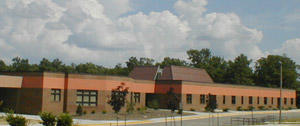What I do all day
I teach Physics to a wide range of high schoolers. Every school in our county has a "Specialty Center" associated with it - a range of classes that run parallel to the regular school day, and students enter the program by application and take these specialty classes while completing their regular school diploma.

At Lloyd C. Bird High School (see picture at right), we are host to the Pre-Engineering Specialty Center. Students who express some interest in studying engineering later in life take a variety of classes designed to prepare them for a college engineering program. They take an introduction to physics as freshman, along with "Foundations of Engineering". They take "Engineering Design" as sophomores. As juniors or seniors there is an "Aerospace Engineering" elective. And as seniors they can take AP Chemistry or AP Physics. And these are just a few of the courses offered as part of the program.
I teach the sophomore Engineering Design class, and the senior AP Physics class. These kids are supposedly the best and brightest, but as an educator and teacher you've got to know that I hate putting kids in categories like that.
Especially because I also teach three sections of "General Physics". Students who have taken Earth Science and Biology have the choice of studying Chemistry, Marine Ecology, or Physics. Usually a student will not study Physics until after Chemistry, and they will take the "Conceptual Physics" course taught by one of my colleagues. However, if a student is not interested in Chemistry (or their Biology teacher does not think they have the aptitude for it), but they still need three science credits for a standard diploma, they can take General Physics.
This is not the position that I am used to putting Physics in...it involves lots of higher-level thinking skills, so I think of it as a higher-level course in the high school curriculum. But now I am discovering a whole new way of applying the principals of physics to every day life, thanks to these students who have a strong grasp on the real world that awaits them outside the high school's doors. They may not be designing the world's next bridges, skyscrapers, and cars, like the engineering kids. But whatever they do, they can have the opportunity to do it thoughtfully and analytically.


2 Comments:
The world needs more teachers like you.
-sm
Amen! (to comment above)
Post a Comment
<< Home